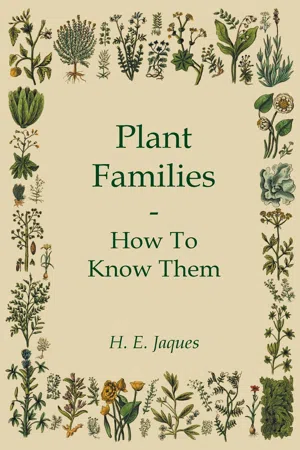
Plant Families - How To Know Them
H. E. Jaques
- 188 pages
- English
- ePUB (adapté aux mobiles)
- Disponible sur iOS et Android
Plant Families - How To Know Them
H. E. Jaques
À propos de ce livre
"Plant Families – How To Know Them" is a 1948 guide to identifying plants by H. E. Jaques. It aims to teach the reader how to readily attribute any and every plant they see to its proper family, as well as to provide them with a general understanding of the characteristics of said family of trees. This accessible and profusely-illustrated guide will appeal to nature lovers and is not to be missed by those with a keen interest in gardening. Contents include: "Some Plant Facts", "A List of Reference Books", "How to Use the Keys", "Pictured-Keys for Identification of the Families of Plants", "Algae", "Lichens", "Mosses and Liverworts", "Ferns", "Flowering Plants", "A List of the Families of Plants in Their Logical Order", and "Index and Illustrated Glossary". Many vintage books such as this are increasingly scarce and expensive. It is with this in mind that we are republishing this volume now in an affordable, modern, high-quality edition complete with a specially-commissioned new introduction on the history of gardening.
Foire aux questions
Informations
PICTURED-KEYS FOR IDENTIFYING THE FAMILIES OF THE ENTIRE PLANT KINGDOM

KEY TO THE PRINCIPAL GROUPS OF PLANTS
1b Plants with distinct leaves; with or without roots or flowers. | 2 |
2b Plants with true roots and vascular bundles; mostly with veiny leaves. | 3 |
THE THALLOPHYTA
KEYS TO THE FAMILIES OF THE ALGAE
2a Plant cells without recognizable nucleus... |